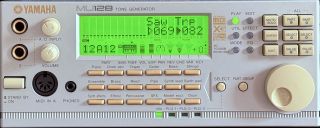Yamaha MU128: Difference between revisions
(Add {{Photo wanted}}) |
mNo edit summary |
||
| (2 intermediate revisions by 2 users not shown) | |||
| Line 1: | Line 1: | ||
{{stub}} | {{stub}} | ||
<!-- If you add or change something in this infobox, consider updating the MU series article's comparison table also. --> | |||
{{Infobox module | {{Infobox module | ||
| name = Yamaha MU128 | | name = Yamaha MU128 | ||
| image = | | image = [[File:Yamaha MU128-front.jpg|320px]] | ||
| dimensions = 219.5 × 91.1 × 229.5<ref name=mu128-om-specs>Yamaha MU128 Owner's Manual, pages 187 and 188.</ref> | | dimensions = 219.5 × 91.1 × 229.5<ref name=mu128-om-specs>Yamaha MU128 Owner's Manual, pages 187 and 188.</ref> | ||
| rackunits = 2U, half-width | | rackunits = 2U, half-width | ||
Latest revision as of 15:20, 27 September 2024
- This article is a stub. Please help DTM Wiki by expanding it.
 |
|
| W × H × D (mm) | 219.5 × 91.1 × 229.5[1] |
|---|---|
| Rack units | 2U, half-width |
| Weight | 1.9kg[1] |
| Type | GM/XG sound module |
| Manufacturer | Yamaha |
| Release date | 1998[2] |
| Standards | General MIDI Yamaha XG[1] TG300B mode[1] General MIDI 2 (with software upgrade)[2] |
| Parts | 64 normal parts[1] 2 A/D parts[3] |
| Max polyphony | 128[1] |
| Normal presets | 1342 (total)[1] 1149 (XG)[1] 664 (TG300B)[1] |
| Drum presets | 47 (total)[1][1] 37 (XG)[1] 10 (TG300B)[1] |
| Expansion | 3× PLG[3] |
| Effects | Reverb (12 types)[1] Chorus (14 types)[1] Variation (70 types)[1] 2× Insertion (43 types)[1] Multi EQ (4 types)[1] Part EQ (1 type)[1] |
| ← Yamaha MU100 | |
| Yamaha MU1000/MU2000 → | |
The Yamaha MU128 is a Yamaha XG and General MIDI sound module in the Yamaha MU series introduced by Yamaha in 1998.
The MU128 doubles the height of the unit versus preceding MU series modules in order to accommodate three XG Plug-in System boards, and doubles the number of voices of polyphony and available parts.[2] It also adds a few more presets and one drumkit relative to the MU100. The manual and faceplate no longer mention the C/M mode, so presumably this was removed, though the C/M banks in the TG300B mode are still present. The increased size is also used to offer buttons for selecting presets by category,[2] and an encoder wheel, providing improved convenience.
The Version 2.0 software update can be installed to add General MIDI 2 support.[2]
References
- ↑ Jump up to: 1.00 1.01 1.02 1.03 1.04 1.05 1.06 1.07 1.08 1.09 1.10 1.11 1.12 1.13 1.14 1.15 1.16 1.17 1.18 Yamaha MU128 Owner's Manual, pages 187 and 188.
- ↑ Jump up to: 2.0 2.1 2.2 2.3 2.4 MU128 - Display Collection - INNOVATION ROAD - Yamaha Corporation
- ↑ Jump up to: 3.0 3.1 Yamaha MU128 Owner's Manual, page 19.